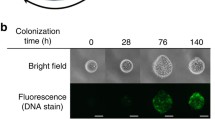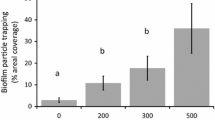Abstract
Scanning electron microscopy observations ofin situ suspended marine and freshwater particles show diverse but similar modes of bacterial and fungal attachment. A survey of Sierra Nevada mountain lakes and pelagic and near-shore waters in the Pacific Ocean indicates that attachment is most noticeable in the near-surface waters where fresh dissolved and particulate input of carbon from phytoplankton and elevated temperatures favor microbial growth. The most common modes of attachment are: adhesive stalk formation, growth on adhesive webs, attachment by the use of pili-like appendages and slimy capsular secretions, and molecular or chemical sorption without the use of visualized structural appendages. Attached microbial growth is accelerated when particulate substrates are supplied, even when they are not rich in organic nutrients. This is the case in the Lake Tahoe basin, where microflora attached to eroded silts can significantly modify the organic carbon and nutrient content of such minerogenous particles.
Similar content being viewed by others
References
Anderson, T. F. 1951. Techniques for the preservation of three dimensional structure in preparing specimens for the electron microscope.Trans. N.Y. Acad. Sci., Sec. 2,13: 130–134.
Armstrong, R., Goldman, C. R., and Fujita, D. K. 1971. A rapid method for the estimation of carbon content of seston and periphyton.Limnol. Oceanogr. 16: 137–139.
Corpe, W. A. 1970. Attachment of marine bacteria to solid surfaces.In: Adhesion in Biological Systems. R. Manly, editor, pp. 73–85. Academic Press, New York.
Floodgate, G. M. 1972. The mechanism of bacterial attachment to detritus in aquatic systems.Mem. Ist. Ital. Idrobiol.; Suppl. 29: 309–323.
Henriksen, A., 1970. Determination of total nitrogen, phosphorus and iron in freshwater by photo-oxidation with ultra-violet irradiation.Analyst 95: 601–608.
Holm-Hansen, O. and Booth, C. R. 1966. The measurement of adenosine triphosphate in the oceans and its ecological significance.Limnol. Oceunogr. 11: 510–519.
Jannasch, H. W. and Pritchard, P. H. 1972. The role of inert particulate matter in the activity of aquatic microorganisms.Mem. Ist. Ital. Idrobiol., Suppl. 29: 289–308.
Lowry, O. H., Roseborough, N. J., Farr, A. L., and Ranstall, R. J. 1951. Protein measurement with the Folin phenol reagent.J. Biol. Chem. 193: 265–275.
Marshall, K. C., Stout, R., and Mitchell, R. 1971. Selective sorption of bacteria from seawater.Can. J. Microbiol. 17: 1413–1416.
Paerl, H. W., 1973. Detritus in Lake Tahoe: Structural modification by attached microflora.Science 180: 496–498.
Paerl, H. W., 1974. Bacterial uptake of dissolved organic matter in relation to detrital aggregation in marine and fresh-water systems.Limnol. Oceanogr. 19: 966–972.
Paerl, H. W. and Goldman, C. R. 1972. Stimulation of heterotrophic and autotrophic activities of a planktonic microbial community by siltation at Lake Tahoe, California.Mem. Ist, Ital. Idrobiol., Suppl. 29: 129–147.
Paerl, H. W. and Shimp, S. L. 1973. Preparation of filtered plankton and detritus for study with scanning electron microscopy.Limnol. Oceanogr. 18: 802–805.
Riley, G. A., 1963. Organic aggregates in sea water and the dynamics of their formation and utilization.Limnol. Oceanogr. 8: 372–381.
Rodina, A. G., 1963. Microbiology of detritus of lakes.Limnol. Oceanogr. 8: 388–393.
Scott, T. A. and Melvin, E. H. 1953. Determination of dextran with anthrone.Anal. Chem. 25: 1656–1666.
Seki, H., 1972. The role of microorganisms in the marine food chain with reference to organic aggregates.Mem. Ist. Ital. Idrobiol., Suppl. 29: 245–259.
Stark, W. H., Stadler, J., and McCoy, E. 1938. Some factors affecting the bacterial populations of freshwater lakes.J. Bacteriol. 36: 653–654.
Stotzky, G., 1967. Clay minerals and microbial ecology.Trans. N.Y. Acad. Sci. 30: 11–21.
Stotzky, 1973. Techniques to study interactions between microorganisms and clay mineralsin vivo andin vitro.Bull. Ecol. Res. Comm. (Stockholm) 17: 17–28.
Waksman, S. A. and Carey, C. L. 1935. Decomposition of organic matter in seawater by bacteria.J. Bacteriol. 29: 531–543.
Wiebe, W. J. and Pomeroy, L. R. 1972. Microorganisms and their association with aggregates and detritus in the sea: A microscopic study.Mem. Ist. Ital. Idrobiol., Suppl. 29: 325–352.
Author information
Authors and Affiliations
Rights and permissions
About this article
Cite this article
Paerl, H.W. Microbial attachment to particles in marine and freshwater ecosystems. Microb Ecol 2, 73–83 (1975). https://doi.org/10.1007/BF02010382
Issue Date:
DOI: https://doi.org/10.1007/BF02010382




